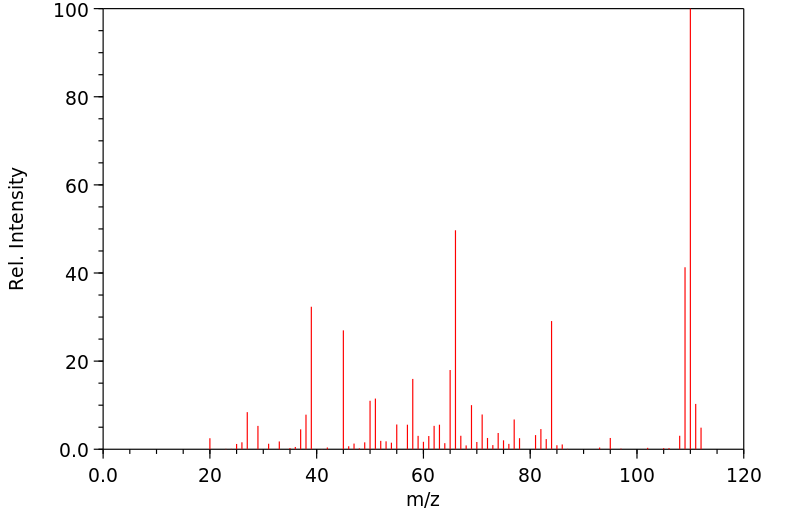2-乙烯基噻吩 | 1918-82-7
中文名称
2-乙烯基噻吩
中文别名
——
英文名称
2-vinylthiophene
英文别名
2-ethenylthiophene;2-thiophene ethylene;2-vinyl thiophen
CAS
1918-82-7
化学式
C6H6S
mdl
MFCD00085296
分子量
110.18
InChiKey
ORNUPNRNNSVZTC-UHFFFAOYSA-N
BEILSTEIN
——
EINECS
——
-
物化性质
-
计算性质
-
ADMET
-
安全信息
-
SDS
-
制备方法与用途
-
上下游信息
-
文献信息
-
表征谱图
-
同类化合物
-
相关功能分类
-
相关结构分类
物化性质
-
沸点:152℃
-
密度:1.050
-
闪点:29℃
-
溶解度:可溶于DMSO(水中的溶解度为)、甲醇(微量)
-
LogP:2.731 (est)
-
保留指数:881;867;867
计算性质
-
辛醇/水分配系数(LogP):2.5
-
重原子数:7
-
可旋转键数:1
-
环数:1.0
-
sp3杂化的碳原子比例:0.0
-
拓扑面积:28.2
-
氢给体数:0
-
氢受体数:1
安全信息
-
海关编码:2934999090
-
储存条件:-20℃
SDS
上下游信息
-
下游产品
中文名称 英文名称 CAS号 化学式 分子量 [E]-1-(2-噻吩基)-1-丙烯 -1-(2-Thienyl)-1-propene 59311-10-3 C7H8S 124.207 (2E)-3-(2-噻吩基)丙烯醛 (E)-2-(2-thienyl)ethylene-1-carbaldehyde 39511-07-4 C7H6OS 138.19 —— 1,2-di-[2]thienyl-ethylene 13640-78-3 C10H8S2 192.306
反应信息
-
作为反应物:参考文献:名称:1,2-二丁氧基乙烷促进在清洁条件下使用 O2 将烯烃氧化裂解为羧酸摘要:在此,我们报告了第一个在清洁条件下使用 1,2-二丁氧基乙烷/O 2系统将烯烃氧化裂解为羧酸的有效且绿色方法的例子。这种新型氧化系统还具有优异的官能团耐受性,适用于大规模合成。通过一锅式顺序转化,无需外部引发剂、催化剂和添加剂,以良好至极好的收率制备了目标产物。DOI:10.1021/acs.joc.1c01701
-
作为产物:参考文献:名称:揭示亚表面氢抑制促进炔烃与水的电化学转移半氢化反应摘要:摘要 与钯基电催化剂相比,以水为氢源的炔烃高选择性电催化半加氢制烯烃具有重要意义,但由于钯的过度加氢能力仍然是一个巨大的挑战。在这里,我们建议理想的钯催化剂应具有弱的烯烃吸附并抑制次表面氢的形成,以刺激炔烃半加氢的高选择性。因此,设计了以KSCN为硫源的固溶界面硫化法制备硫改性Pd纳米线(Pd-S NWs)。S的引入削弱了烯烃的吸附并阻止了活性氢(H*)扩散到Pd晶格中形成不利的次表面H*。因此,在 Pd-S NWs 阴极上实现了电催化炔烃半加氢反应,该阴极具有广泛的底物范围、与电位无关的高达 99% 的烯烃选择性、良好的脆性基团相容性以及易于合成的氘代烯烃。提出了该半加氢反应的吸附氢加成机理。重要的是,通过原位添加 SCN 轻松修改商业 Pd/C−能够以 99% 的选择性和 95% 的转化率合成克级烯烃,突出了我们方法的巨大潜力。DOI:10.1016/s1872-2067(22)64145-7
文献信息
-
Hydrazines and Azides via the Metal-Catalyzed Hydrohydrazination and Hydroazidation of Olefins作者:Jérôme Waser、Boris Gaspar、Hisanori Nambu、Erick M. CarreiraDOI:10.1021/ja062355+日期:2006.9.1which the H and the N atoms come from two different reagents, a silane and an oxidizing nitrogen source (azodicarboxylate or sulfonyl azide). The hydrohydrazination reaction using di-tert-butyl azodicarboxylate is characterized by its ease of use, large functional group tolerance, and broad scope, including mono-, di-, tri-, and tetrasubstituted olefins. Key to the development of the hydroazidation报道了 Co 和 Mn 催化的烯烃加氢肼和加氢叠氮化反应的发现、研究和实施。这些反应等效于 CC 双键与受保护的肼或偶氮酸的直接加氢胺化,但基于不同的概念,其中 H 和 N 原子来自两种不同的试剂,硅烷和氧化性氮源(偶氮二羧酸或磺酰叠氮化物) )。使用偶氮二羧酸二叔丁酯的加氢肼反应具有使用方便、官能团耐受性大、适用范围广的特点,包括单、二、三和四取代烯烃。氢叠氮化反应发展的关键是使用磺酰叠氮化物作为氮源和叔丁基过氧化氢的活化作用。发现该反应对于单、二和三取代烯烃的官能化是有效的,并且只有少数官能团是不能容忍的。获得的烷基叠氮化物是通用中间体,可以在不分离叠氮化物的情况下转化为游离胺或三唑。初步的机理研究表明,烯烃的氢化钴是限速的,然后是胺化反应。不能排除并可能涉及自由基中间体。然后进行胺化反应。不能排除并可能涉及自由基中间体。然后进行胺化反应。不能排除并可能涉及自由基中间体。
-
Terminal Alkenes from Acrylic Acid Derivatives via Non-Oxidative Enzymatic Decarboxylation by Ferulic Acid Decarboxylases作者:Godwin A. Aleku、Christoph Prause、Ruth T. Bradshaw-Allen、Katharina Plasch、Silvia M. Glueck、Samuel S. Bailey、Karl A. P. Payne、David A. Parker、Kurt Faber、David LeysDOI:10.1002/cctc.201800643日期:2018.9.7Fungal ferulic acid decarboxylases (FDCs) belong to the UbiD‐family of enzymes and catalyse the reversible (de)carboxylation of cinnamic acid derivatives through the use of a prenylated flavin cofactor. The latter is synthesised by the flavin prenyltransferase UbiX. Herein, we demonstrate the applicability of FDC/UbiX expressing cells for both isolated enzyme and whole‐cell biocatalysis. FDCs exhibit真菌阿魏酸脱羧酶 (FDC) 属于 UbiD 酶家族,通过使用异戊二烯化黄素辅因子催化肉桂酸衍生物的可逆(脱)羧化。后者由黄素异戊烯基转移酶 UbiX 合成。在此,我们证明了 FDC/UbiX 表达细胞对于分离酶和全细胞生物催化的适用性。 FDC表现出高活性,总周转数(TTN)高达55000,周转频率(TOF)高达370 min -1 。共溶剂相容性研究表明,FDC 对某些有机溶剂的耐受性高达 20% v/v。利用 Holo-FDC 的体外(脱)羧酶活性以及全细胞生物催化剂,我们对三种 FDC 进行了底物分析研究,为活性的结构决定因素提供了见解。 FDC 对多种 C3 处带有(杂)环或烯属取代基的丙烯酸衍生物表现出广泛的底物耐受性,转化率高达 >99%。 FDC 的合成效用通过制备规模的脱羧得到了证明。
-
Model Guided Development of a Simple Catalytic Method for the Synthesis of Unsymmetrical Stilbenes by Sequential Heck Reactions of Aryl Bromides with Ethylene作者:Helen Barlow、Jonas Y. Buser、Hendrik Glauninger、Carla V. Luciani、Joseph R. Martinelli、Niall Oram、Nichole Thompson‐Van Hook、Jeffery RichardsonDOI:10.1002/adsc.201800167日期:2018.7.16moieties, but methods for their preparation typically possess numerous inefficiencies. Presented here is a methodology for the two‐step, one pot preparation of unsymmetrical stilbenes via sequential Heck reactions. The first Heck reaction with ethylene gas was analysed as a function of temperature and pressure for electronically differentiated naphthyl bromides and model‐aided reaction optimization was utilized
-
Iodosobenzene-Mediated Three-Component Selenofunctionalization of Olefins作者:Zhi-Peng Liang、Wei Yi、Peng-Fei Wang、Gong-Qing Liu、Yong LingDOI:10.1021/acs.joc.1c00257日期:2021.4.2A three-component reaction of olefin, diselenide and water, alcohols, phenol, carboxylic acid, or amine by a commercially available hypervalent iodine(III) reagent, PhIO, was developed. This method provides access to a wide range of vicinally functionalized selenoderivatives under ambient conditions with mostly excellent yields and high diastereoselectivity. The developed reaction displays high levels
-
Visible Light-Driven Azidation/Difunctionalization of Vinyl Arenes with Azidobenziodoxole under Copper Catalysis作者:Danhua Wu、Shuang-Shuang Cui、Yajun Lin、Lin Li、Wei YuDOI:10.1021/acs.joc.9b01569日期:2019.9.6products, which correspond to reaction patterns of amido-azidation, benzoyloxy-azidation, and diazidation. The electronic nature of the aryl group attached to the olefin moiety was found to play a crucial role in determining the reaction consequence: when the aryl group was electron-rich, the reactions afforded benzoyloxy-azidation products exclusively; for highly electron-deficient vinyl arenes, by contrast使用Cu(I)(菲咯啉)2络合物[Cu(dap)2 ] PF 6在乙腈中研究了以叠氮基苯并恶唑为叠氮化剂的乙烯基芳烃的可见光驱动叠氮化。作为光催化剂。该反应产生三种类型的双官能化产物,其对应于酰胺基叠氮化,苯甲酰氧基叠氮化和重氮化的反应模式。发现连接至烯烃部分的芳基的电子性质在确定反应结果中起关键作用:当芳基富含电子时,该反应仅提供苯甲酰氧基叠氮化产物。相比之下,对于高度缺电子的乙烯基芳烃,重氮化产物的产率中等。另一方面,当芳基为中等电子富集或电子不足时,涉及乙腈以及叠氮苯并恶唑的三组分反应发生,主要得到酰胺叠氮化产物。在机理研究的基础上,提出了一种合理的机制来合理化这些结果。电子偏性较低的乙烯基芳烃的反应可能通过氧化还原催化途径进行,而富电子烯烃被认为是通过自由基链过程转化的。本发明的反应可能具有合成用途,因为它们为乙烯基芳烃的酰胺化提供了一种新的方法。
表征谱图
-
氢谱1HNMR
-
质谱MS
-
碳谱13CNMR
-
红外IR
-
拉曼Raman
-
峰位数据
-
峰位匹配
-
表征信息
同类化合物
香薷二醇
顺式-1-(2-呋喃基)-1-戊烯
顺-1,2-二氰基-1,2-双(2,4,5-三甲基-3-噻吩基)乙烯
顺-1,2-(2-噻嗯基)二乙烯
雷尼替丁-N,S-二氧化物
雷尼替丁-N-氧化物
钴(II)双[(2-吡啶基甲基)(叔丁基二甲基甲硅烷基)酰胺]
西拉诺德
螺[环氧乙烷-2,3'-吡咯并[1,2-a]吡嗪]
萘并[2,1,8-def]喹啉
苯硫基溴化镁
苯甲酸,2-[[[7-[[(3.β.)-3-羟基-28-羰基羽扇-20(29)-烯-28-基]amino]庚基]氨基]羰基]
苍术素
羟胺,O-[4-(2-呋喃基)丁基]-
缩水甘油糠醚
紫苏烯
糠醛肟
糠醛氰醇的1-乙氧基乙基醚
糠醇-d2
糠醇
糠基硫醇-d2
糠基硫醇
糠基甲基硫醚
糠基氯
糠基氨基甲酸异丙酯
糠基丙基醚
糠基丙基二硫醚
糠基3-巯基-2-甲基丙酸酯
糠基-异戊基醚
糠基-异丁基醚
糠基 2-甲基-3-呋喃基二硫醚
磷杂茂
碘化N,N,N-三甲基丁烷-1-铵
硫酸异丙基糠酯
硫代磷酸O-糠基O-甲基S-(2-丙炔基)酯
硫代磷酸O-乙基O-糠基S-(2-丙炔基)酯
硫代甲酸S-糠酯
硫代噻吩甲酰基三氟丙酮
硫代乙酸糠酯
硫代丙酸糠酯
硒吩-3-羧酸酰肼
硅烷,三(1-甲基乙基)[(3-甲基-2-呋喃基)氧代]-
硅烷,[2-(3-呋喃基)乙烯基]三甲基-,(E)-
硅烷,(1,1-二甲基乙基)(2-呋喃基甲氧基)二甲基-
砷杂苯
甲酸糠酯
甲氧亚胺基呋喃乙酸铵盐
甲基糠基醚
甲基糠基二硫
甲基呋喃-2-基甲基氨基甲酸酯







